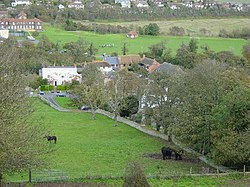Ovingdean
| Ovingdean | |
| Sussex | |
|---|---|
 Ovingdean from Cattle Hill | |
| Location | |
| Grid reference: | TQ357034 |
| Location: | 50°48’52"N, 0°4’26"W |
| Data | |
| Post town: | Brighton |
| Postcode: | BN2 |
| Dialling code: | 01273 |
| Local Government | |
| Council: | Brighton and Hove |
| Parliamentary constituency: |
Brighton Kemptown |
Ovingdean is a village in the very south of Sussex, close to the coast and now barely separated from the swelling conurbation growing out of Brighton to the west. The village separated by a low hill, Red Hill, from the eastern edge of Brighton and its marina. It runs down the hill to join neighbouring Rottingdean.
The village has expanded through the growth of residential streets on its eastern and southern sides, and now has a population of about 1,200. Some of the current housing replaces earlier shacks of the type once found in neighbouring Woodingdean and Peacehaven, built after the First World War. It almost abuts Rottingdean to the south-east and Woodingdean to the north-east, but still has open downland on its other sides, on which may be found a golf course and Brighton racecourse as well as some residual farmland.
The village has a single shop (a sub-post office) and no pubs.
History and heritage
The village is said to have been attacked by French raiders in the known incursion of 1377, but there is no hard evidence for this.[1]
The historic village is a conservation area. Its focus is the 11th century St Wulfram's Church: This church dedication, to Wulfram of Sens, was only ever found in two other places in Britain, namely Grantham and Dorrington, both in Lincolnshire; and it has vanished at Dorrington.[1][2]
Many homes in the conservation area are converted farm buildings, and the most prominent houses are Ovingdean Grange and Ovingdean Hall. The Grange is the subject of legend. In 1857, the popular novelist W. Harrison Ainsworth wrote Ovingdean Grange, A Tale Of The South Downs, in which he described how the future King Charles II stayed there for less than 24 hours before escaping to France in 1651, fathering a child in the process. In reality, the King stayed at the George Inn in West Street, Brighton. The Hall is a gentry mansion which was the birthplace of Charles Eamer Kempe, the stained glass window designer. It now serves as a language school for overseas residential students, Ovingdean Hall School. The majority of pupils are partially deaf or are equipped with cochlear implants. Longhill High School, a comprehensive school, is on the edge of the village, with its postal address in Rottingdean.
Among those buried in the churchyard are the inventor [[Magnus Volk (creator of Brighton's Volks Electric Railway), the stained-glass artist Charles Kempe and the distinguished lawyer Helena Normanton, one of the first female barristers.
About the village
Just outside the historic boundary of Ovingdean is Ian Fraser House, better known as St Dunstan's, a famous residential and rehabilitation centre for blind ex-servicemen. It was also the home of 113-year-old Henry Allingham, the last surviving founder-member of the RAF and briefly the world's oldest man.
Ovingdean is now the site of several proposed urban fringe sites due development under Brighton and Hove City Plan.[3]
Outside links
| ("Wikimedia Commons" has material about Ovingdean) |
References
- ↑ 1.0 1.1 Dale, Antony (1989). Brighton Churches. London: Routledge. p. 205. ISBN 0-415-00863-8.
- ↑ "St Wulfran's Church, Ovingdean". My Brighton and Hove website. My Brighton and Hove (c/o QueensPark Books). 2007-09-12. http://www.mybrightonandhove.org.uk/page_id__6600_path__0p115p187p784p.aspx.
- ↑ "Brighton & Hove Proposed Submission City Plan Part One". Brighton & Hove City Council. February 2013. http://www.brighton-hove.gov.uk/sites/brighton-hove.gov.uk/files/downloads/ldf/Proposed_Submission_City_Plan_Part_One.pdf.
- Carder, Tim: 'The encyclopaedia of Brighton' (1991)
- Coates, Richard: 'A history of Rottingdean and Ovingdean through their place-names' (English Place-Name Society, 2010)
- Davies, John G.: research papers deposited locally
